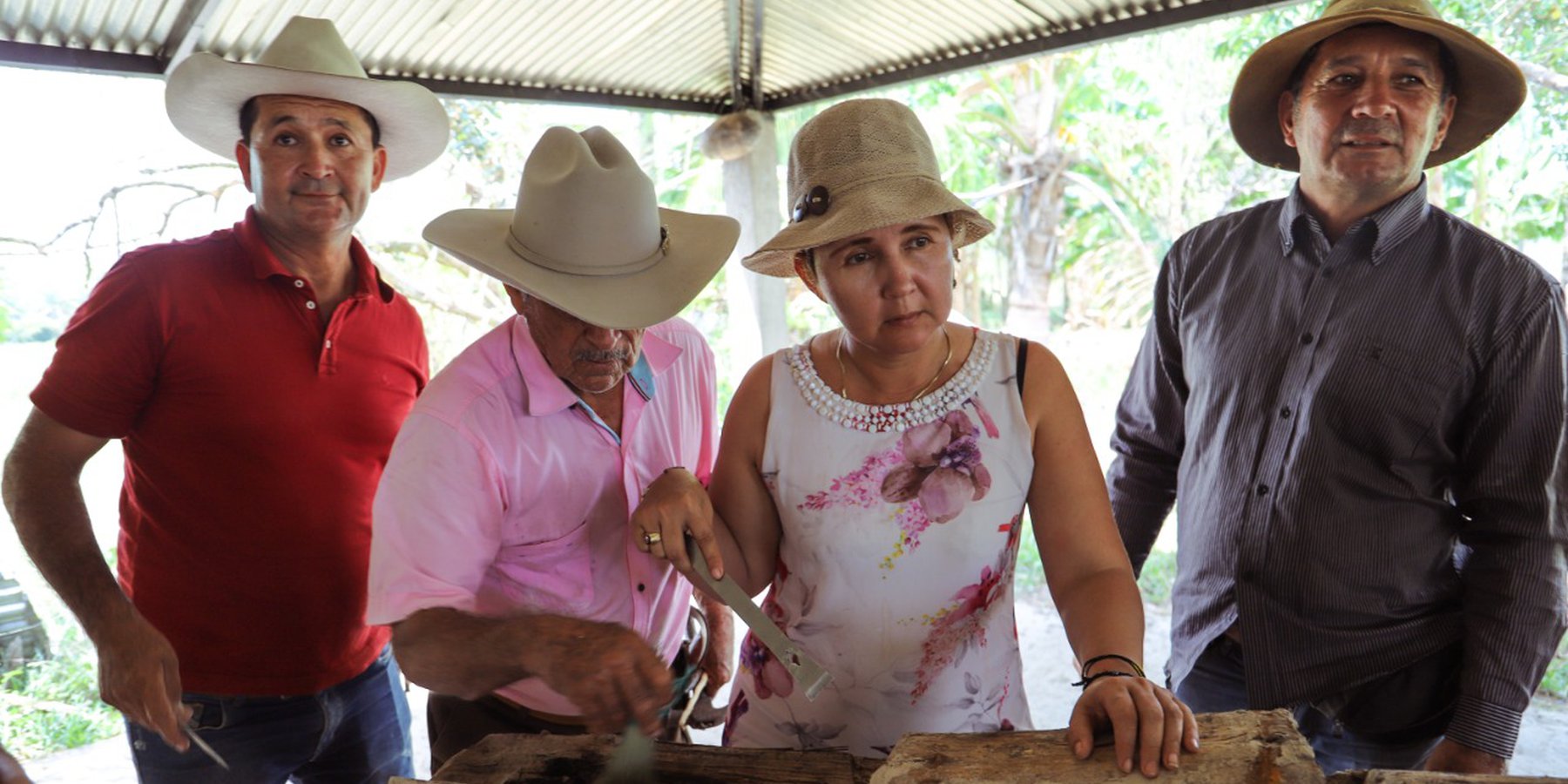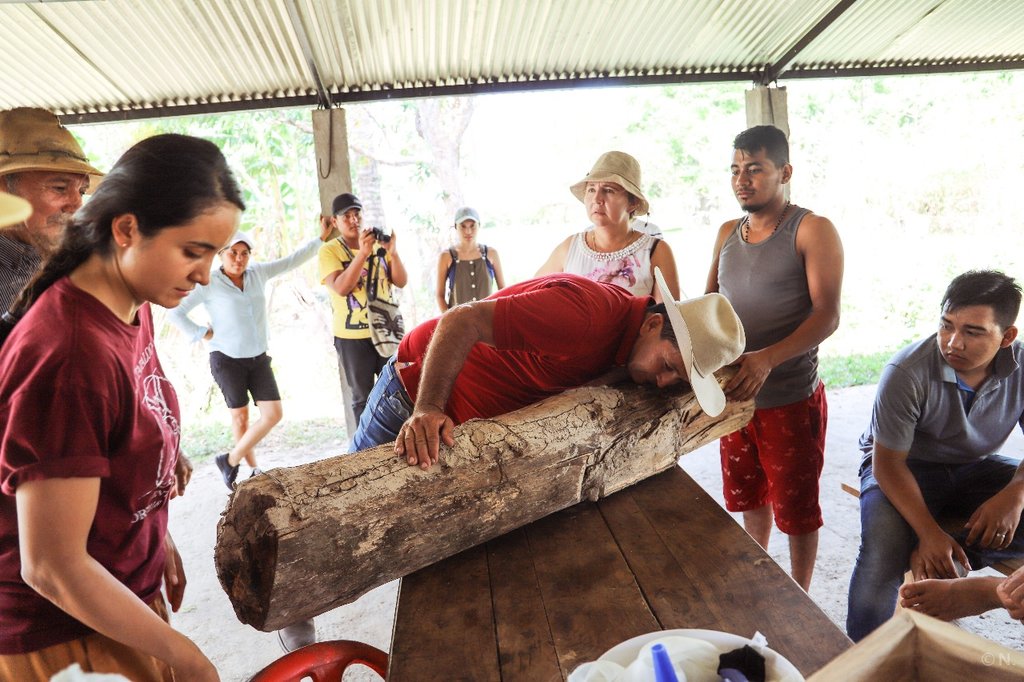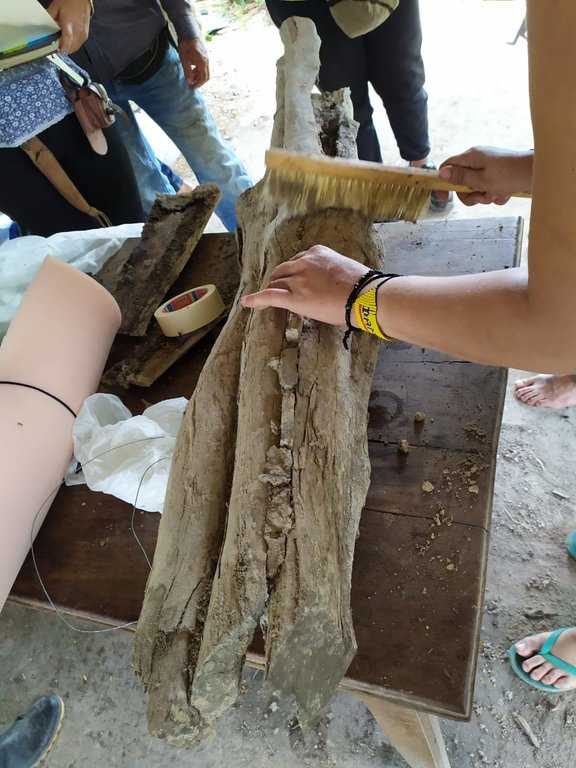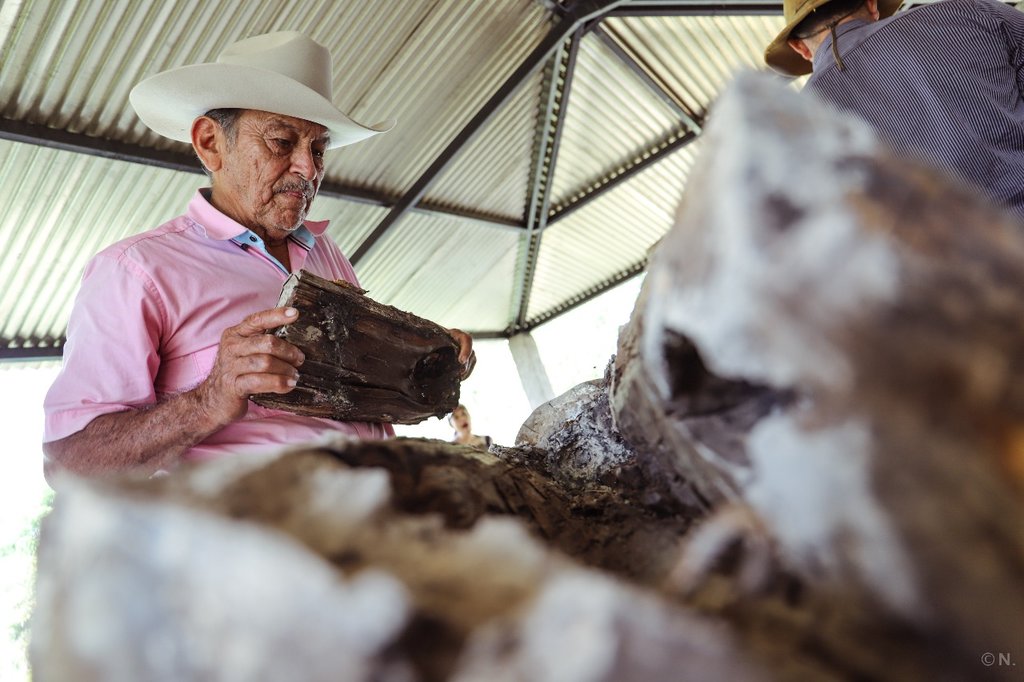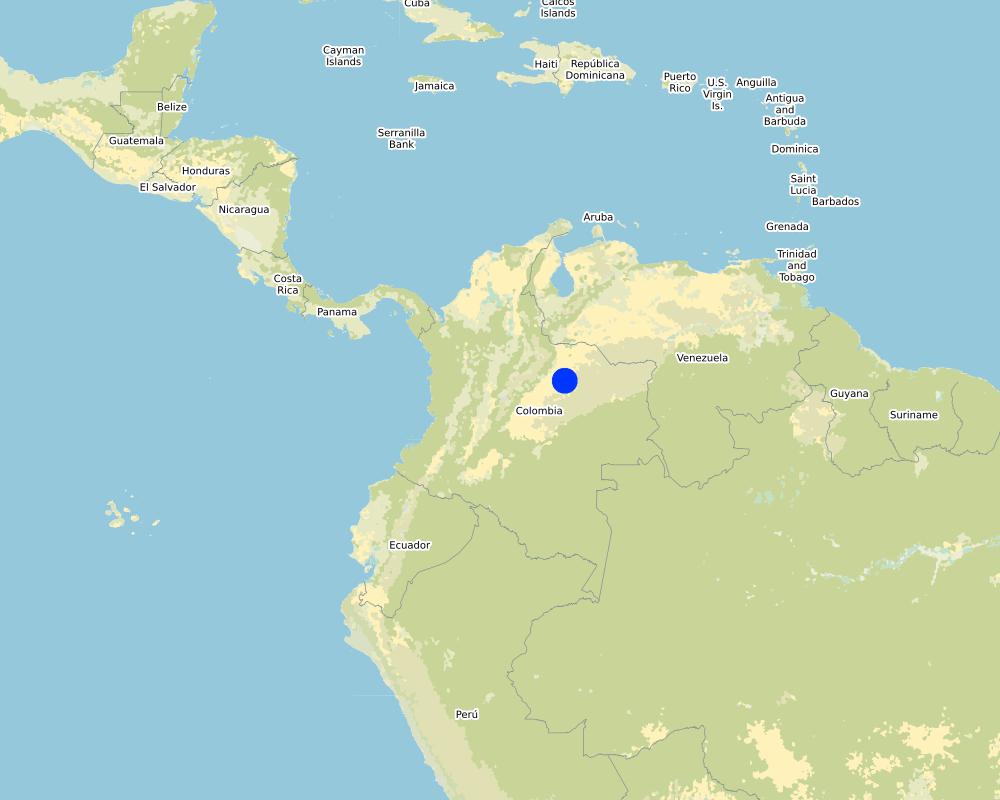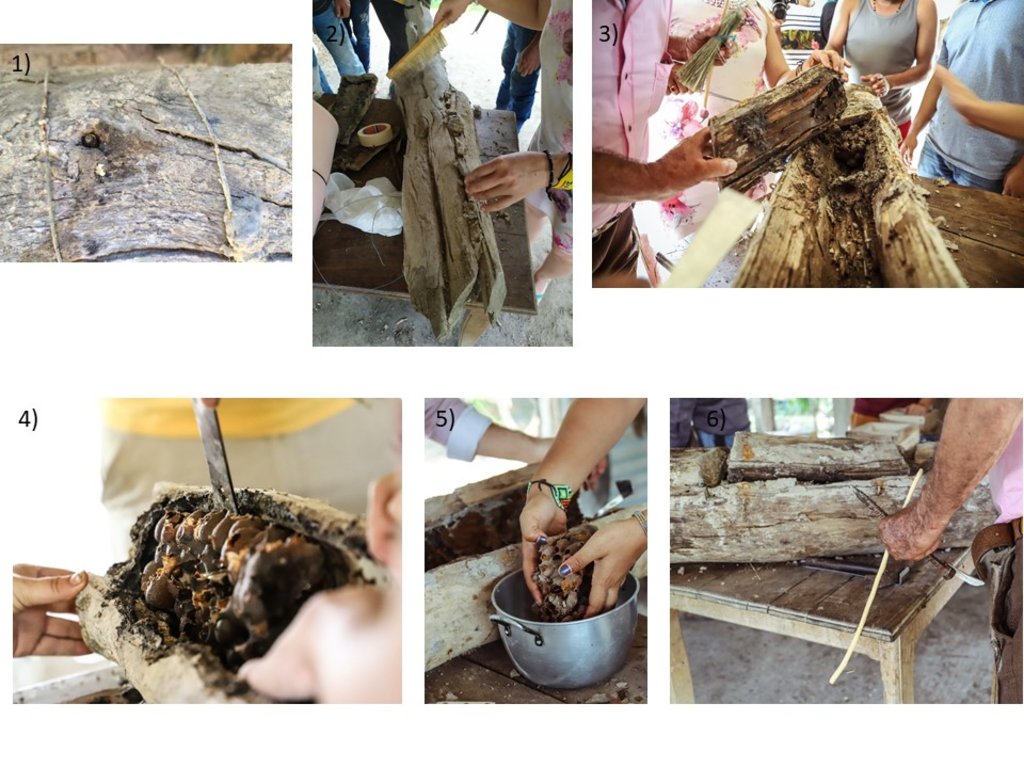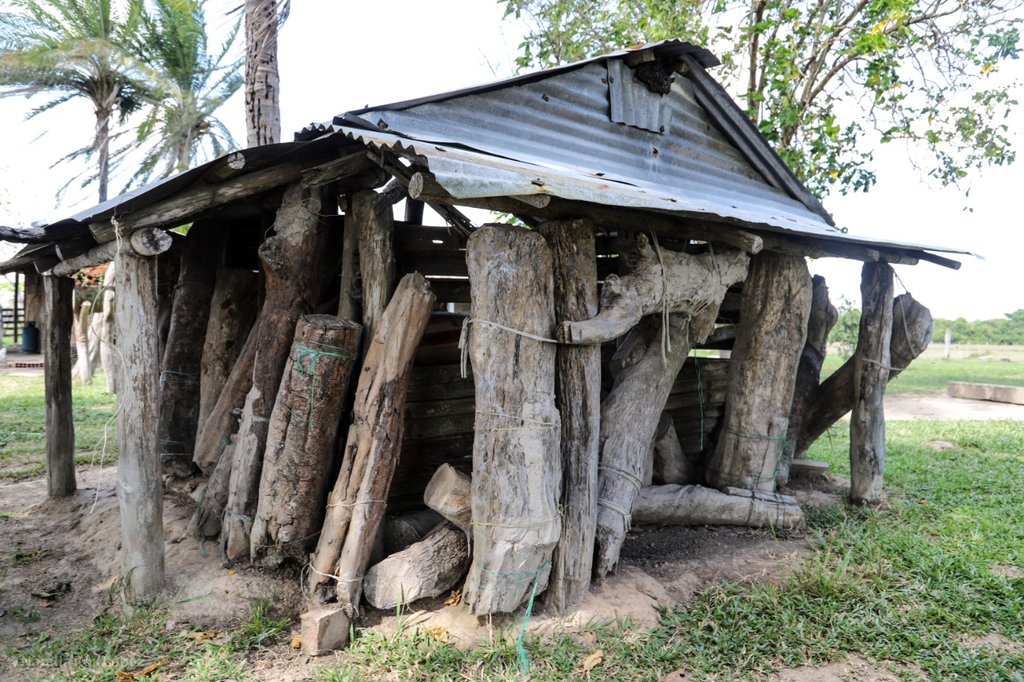Sustainable traditional native bee (Melipona favosa) keeping [Colombia]
- Creación:
- Actualización:
- Compilador: Beatriz Ramirez
- Editor: Luisa F. Vega
- Revisor: Hanspeter Liniger
Cría de abeja mancita
technologies_5797 - Colombia
Visualizar secciones
Expandir todo Colapsar todos1. Información general
1.2 Detalles de contacto de las personas de referencia e instituciones involucradas en la evaluación y la documentación de la Tecnología
Persona(s) de referencia clave
usuario de la tierra:
Abril Héctor
Finca La Reforma
Colombia
usuario de la tierra:
Abril Héctor Frugo
Finca La Corocora
Colombia
usuario de la tierra:
Abril Damaris
Finca La Esmeralda
Colombia
usuario de la tierra:
Abril Boncieth
Finca Arbolitos
Colombia
usuario de la tierra:
Abril Héctor Daniel
Finca La Berraquera
Colombia
Nombre de la(s) institución(es) que facilitaron la documentación/ evaluación de la Tecnología (si fuera relevante)
Centro de Estudios Ambientales de la Orinoquia- Asociación de Becarios de Casanare (ABC) - Colombia1.3 Condiciones referidas al uso de datos documentados mediante WOCAT
El compilador y la/s persona(s) de referencia claves aceptan las condiciones acerca del uso de los datos documentados mediante WOCAT:
Sí
1.4 Declaración de la sostenibilidad de la Tecnología descrita
¿La Tecnología aquí descrita resulta problemática en relación a la degradación de la tierra, de tal forma que no puede considerársela una tecnología sostenible para el manejo de la tierra?
No
2. Descripción de la Tecnología MST
2.1 Breve descripción de la Tecnología
Definición de la Tecnología:
Native stingless bee keeping (Melipona favosa) protects bees and plants found in forest and savannah ecosystems to produce honey. In contrast to current destructive wild bee honey harvesting, members of the Abril family keep the traditional practice of capturing/rescuing wild nests, and adapt them so that honey can be extracted from the same nest for many years (up to 30 y) without killing the bees.
2.2 Descripción detallada de la Tecnología
Descripción:
Native bee honey production in the floodable savannahs of the eastern Colombian Llanos (Orinoco River Basin), relies on stingless bees of the species Melipona favosa. These bees nest inside tree trunks. The main characteristics of the native bee keeping, as currently performed by three generations of the Abril Family, is that it is sustainable, promotes de conservation of native ecosystems, and as far as we know, constitutes the only sustainable and profitable direct use of local biodiversity in the floodable savannahs of the eastern Llanos in Colombia. Its sustainability is due to the adaptations and management of the nests, so that honey can be extracted without damaging the bees. On one hand, they know how to retrieve wild nests, either by rescuing them from rotten trees or the ground, or by cutting the branch with the nest, and then keeping its natural position at all times. Once at their houses, they will study the outside of the nest and listen to the bees inside the nest, with this information they will cut out a part of the tree trunk to create a window. Once opened, they verify the location of the honey and pollen pots and the broods. Then, they will reattach the cut part on to the trunk by using metal wire and sealing the edges with mud. The nest will be hanged with wire in the position it was originally found. Once on site they will check every day for the presence of the sentinel bee and bee activity. Furthermore, they only extract honey during the end of the dry season when bees have enough food reserves. For the extraction, they will reopen the previously cut window, and extract the honey and pollen pots, making sure enough are left behind so that bees can have access to food as well. The mean honey production from each nest is around the 750 ml- 1000 ml. Honey is kept for their own use and sold to some people for a fairly high price (30 dollars per 750 ml). The honey is mainly consumed as a medicinal product, and its low quantity makes it highly sought after. If someone requests it for sight issues, Héctor will extract the honey with a syringe so that it is as clear as possible.
The native bee keeping contributes to protect native bees, as the management of nests can keep them functional for up to 30 years. The Abril family members are well aware of the dependency between honey production and presence of native plants from where bees forage for nectar and pollen. Therefore, they avoid forest clearing and selectively keep shrubs in the grasslands to guarantee food supply for their bees. Also, they plant fruit trees such as guayaba (Psidium guajava) and arazá (Eugenia stipitata), that benefit the bees, which at the same time benefit pollination. Fruit production is mainly used for home use and very seldom they are sold. They also witness the negative impacts that agrochemical airborne dispersion from rice production in the neighbouring farms, have on wild bee populations. So far, their main concern is that they do not know how to multiply the nests.
2.3 Fotografías de la Tecnología
2.4 Videos de la Tecnología
Comentarios, descripción breve:
They are harvesting the honey from the pots throught the window, without affecting the brooding area. https://youtu.be/ZS_TbwV3fnw
Fecha:
30/01/2020
Lugar:
Finca La Reforma, Vereda Los chochos, Municipality: Trinidad, Department: Casanare, Colombia
Nombre del videógrafo:
Mildred Sossa
2.5 País/ región/ lugares donde la Tecnología fue aplicada y que se hallan comprendidos por esta evaluación
País:
Colombia
Región/ Estado/ Provincia:
Casanare
Especifique más el lugar :
Municipality: Trinidad, Vereda: Los Chochos
Especifique la difusión de la Tecnología:
- aplicada en puntos específicos/ concentrada en un área pequeña
¿El/los sitio(s) de la Tecnología se ubica(n) en un área de protección permanente?
No
Comentarios:
All farms are neighbors and they all belong to the Abril family members (Father, two sons and a daughter)
Map
×2.6 Fecha de la implementación
Si no se conoce el año preciso, indique la fecha aproximada:
- 10-50 años atrás
2.7 Introducción de la Tecnología
Especifique cómo se introdujo la Tecnología:
- como parte de un sistema tradicional (> 50 años)
Comentarios (tipo de proyecto, etc.):
Héctor Abril, has been working with this traditional systems since more than 50 years ago. The traditional system consists in creating a window implied o extract honey without damaging the nest. This knowledge has been passed on to his sons and daughter.
3. Clasificación de la Tecnología MST
3.1 Propósito(s) principal(es) de la Tecnología MST
- mejorar la producción
- conservar el ecosistema
- preservar/ mejorar biodiversidad
- crear impacto económico benéfico
3.2 Tipo(s) actuales de uso de la tierra donde se aplica la Tecnología
Mezcla de tipos de uso de tierras dentro de la misma unidad de tierras: :
No

Tierra de pastoreo
Pastoreo extenso:
- Ganadería de hacienda
Tipo de animal:
- ganado - carne de res no lechera
¿Se practica el manejo integrado de cultivos - ganado?
No
Productos y servicios:
- carne
Especies:
ganado - carne de res no lechera
Conteo:
150
Especies:
beekeeping, apiculture
Conteo:
80

Bosques
- Bosques/ zonas boscosas (semi) naturales
Bosques/ zonas boscosas (semi-) naturales: Especifique tipo de manejo:
- Tala selectiva
- Uso de productos forestales no madereros
Tipo de bosque (semi)natural:
- vegetación natural de bosque tropical húmedo
- vegetación natural de monte tropical
- Natural strips of gallery forest along savannah's rivers
Comentarios:
The main economic activity of this group of farms is extensive cattle ranching on natural floodable savannhas (242 ha), but they all have bee keeping in their houses. The number 80 refers to the nest quantity. They preserve gallery forests (108 ha) and allow for fallows (28 ha) to develope near the houses for supplying nectar and pollen to the bees.
3.3 ¿Cambió el uso de tierras debido a la implementación de la Tecnología?
¿Cambió el uso de tierras debido a la implementación de la Tecnología?
- Sí (Por favor responda las preguntas de abajo referidas al uso de la tierra antes de implementar la Tecnología)
Mezcla de tipos de uso de tierras dentro de la misma unidad de tierras: :
No

Bosques
- Bosques/ zonas boscosas (semi) naturales
Bosques/ zonas boscosas (semi-) naturales: Especifique tipo de manejo:
- Uso de productos forestales no madereros
Tipo de bosque (semi)natural:
- vegetación natural de bosque tropical húmedo
- vegetación natural de monte tropical
Comentarios:
The fact that their traditional practice allow for them to keep the bee nests in their houses for up to 30 years, means that they had to protect surrounding forests and allow for shrubland recovery nearby the house. Otherwise, they would just either collect honey directly in the field in a single destructive event or bring a couple of nests per year home and then extract honey in a destructive way.
3.4 Provisión de agua
Provisión de agua para la tierra donde se aplica la Tecnología:
- de secano
Comentarios:
The farms have some windmills for water extraction for the cattle ranching, but these are not used for the natural ecosystems that sustain the bees during the dry season.
3.5 Grupo MST al que pertenece la Tecnología
- apicultura, acuacultura, avicultura, cunicultura, sericicultura, etc.
3.6 Medidas MST que componen la Tecnología

medidas vegetativas
- V1: Cubierta de árboles y arbustos

medidas de manejo
- M1: Cambio de tipo de uso de la tierra
Comentarios:
Bee keeping implies supplying the bees nectar and polen demands, thus, for sustaining their bees the Abril family is particularly keen on protecting their gallery forests and allow shrub regeneration. In addition, they are cultivating fruit trees (guayaba- Psidium guajava; arazá- Eugenia stipitata) near the houses, impplying a change in land cover from grazing land to fruit crops.
3.7 Principales tipos de degradación de la tierra encarados con la Tecnología

erosión de suelos por agua
- Wt: pérdida de capa arable/ erosión de la superficie

erosión de suelos por viento
- Et: pérdida de capa arable

deterioro físico del suelo
- Pc: compactación

degradación biológica
- Bh: pérdida de hábitats
- Bs: reducción en la calidad y composición/ diversidad de las especies
Comentarios:
Forest conservation and shrub recovery and fruit crops aid in the reduction of erosion by water during the wet season, and erosion by wind during the dry season. Forest conservation and shrub recovery and fruit crops reduce areas exposed to cattle trampling. Forest conservation, shrub recovery and fruit crops are likely important to protect soil fauna, to enhance the survival of bees and many other animal and plant species. A high density of pollinators is also important for natural vegetation and fruitting crop
3.8 Prevención, reducción o restauración de la degradación de la tierra
Especifique la meta de la Tecnología con relación a la degradación de la tierra:
- prevenir la degradación de la tierra
Comentarios:
On the one hand, they actively preserve the riparian forests because of their awareness of the relation between bee survival and honey production with forest cover. This reduces land degradation. On the other hand, surrounding their houses where they keep the bees they have planted trees and allowed for fallow areas to offer pollen and nectar to their bees, restoring land that has been previously used for cattle ranching
4. Especificaciones técnicas, actividades de implementación, insumos y costos
4.1 Dibujo técnico de la Tecnología
Especificaciones técnicas (relacionadas al dibujo técnico):
This is too complex to draw, so we presented the sequence of extracting honey in a nest that has been modified so that the nest can live up to 30 years.
Autor:
Natalia Roa y Beatriz Ramírez
Fecha:
30/01/2020
Especificaciones técnicas (relacionadas al dibujo técnico):
This is the housing for the nests. These nests have been collected or rescued from field. The youngest has 3 years the oldest has around 30 years. It is very important to keep the nests in the position they were originally found. The housing is to prevent direct sunshine and rainfall exposition.
Autor:
Natalia Roa
Fecha:
30/01/2020
4.2 Información general sobre el cálculo de insumos y costos
Especifique cómo se calcularon los costos e insumos:
- por unidad de Tecnología
Especifique unidad:
bee nest
Especifique la moneda usada para calcular costos:
- USD
Indique el costo promedio del salario de trabajo contratado por día:
$ 15
4.3 Actividades de establecimiento
| Actividad | Momento (estación) | |
|---|---|---|
| 1. | Wild nest recue or extraction and transport to the house | Depends on the finding, but it is preferred in the dry season where more floral resources are available |
| 2. | Opening of a window in the nest | A couple of days after being collected/recued |
| 3. | Locating the nest under housing | Just after the window opening |
4.4 Costos e insumos necesarios para el establecimiento
| Especifique insumo | Unidad | Cantidad | Costos por unidad | Costos totales por insumo | % de los costos cubiertos por los usuarios de las tierras | |
|---|---|---|---|---|---|---|
| Mano de obra | Two people for wild nest recue or extraction and transport to the house | day | 2,0 | 15,0 | 30,0 | 100,0 |
| Mano de obra | Opening of a window in the nest | day | 0,5 | 15,0 | 7,5 | 100,0 |
| Mano de obra | Housing construction (two people) | day | 2,0 | 15,0 | 30,0 | 100,0 |
| Mano de obra | 100,0 | |||||
| Equipo | Saw | unit | 1,0 | 20,0 | 20,0 | 100,0 |
| Equipo | Chissel | unit | 1,0 | 10,0 | 10,0 | 100,0 |
| Equipo | hammer | unit | 1,0 | 8,0 | 8,0 | 100,0 |
| Equipo | Metal wire | kilo | 0,5 | 11,0 | 5,5 | 100,0 |
| Equipo | Ax | unit | 1,0 | 20,0 | 20,0 | 100,0 |
| Material de construcción | boles minimum 15 cm diamater and 2 m of height | boles | 4,0 | 8,0 | 32,0 | 100,0 |
| Material de construcción | wood support 4 m long | unit | 4,0 | 6,0 | 24,0 | 100,0 |
| Material de construcción | Roof laminas (3 m) | laminas | 3,0 | 18,0 | 54,0 | 100,0 |
| Material de construcción | Nails | box | 2,0 | 9,0 | 18,0 | 100,0 |
| Costos totales para establecer la Tecnología | 259,0 | |||||
| Costos totales para establecer la Tecnología en USD | 259,0 | |||||
Comentarios:
The construction of a bee nest house can hold up to 30 bee nests.
4.5 Actividades de establecimiento/ recurrentes
| Actividad | Momento/ frequencia | |
|---|---|---|
| 1. | Checking the bee nests | daily |
| 2. | Harvesting honey | yearly |
| 3. | Seedling collection | monthly |
| 4. | tree nursery care | daily |
| 5. | planting trees | monthly |
4.6 Costos e insumos necesarios para actividades de mantenimiento/ recurrentes (por año)
| Especifique insumo | Unidad | Cantidad | Costos por unidad | Costos totales por insumo | % de los costos cubiertos por los usuarios de las tierras | |
|---|---|---|---|---|---|---|
| Mano de obra | Daily check per bee nest | day | 0,005 | 15,0 | 0,07 | 100,0 |
| Mano de obra | honey harvest per bee nest (2 people) | day | 1,0 | 15,0 | 15,0 | 100,0 |
| Mano de obra | Seedling collection | month | 2,0 | 15,0 | 30,0 | 100,0 |
| Mano de obra | Planting of fruitting trees | month | 2,0 | 15,0 | 30,0 | 100,0 |
| Equipo | Chissel | unit | 1,0 | 10,0 | 10,0 | 100,0 |
| Equipo | Broom | unit | 1,0 | 3,0 | 3,0 | 100,0 |
| Equipo | Hammer | unit | 1,0 | 8,0 | 8,0 | 100,0 |
| Equipo | Syringe | unit | 1,0 | 0,2 | 0,2 | 100,0 |
| Equipo | Empty glass bottles (750 ml) | unit | 70,0 | 0,4 | 28,0 | 100,0 |
| Equipo | Table | unit | 1,0 | 30,0 | 30,0 | 100,0 |
| Equipo | shovel | unit | 1,0 | 20,0 | 20,0 | 100,0 |
| Material para plantas | Bags x 50 units | bag | 1,0 | 5,0 | 5,0 | 100,0 |
| Material para plantas | Soil | sack | 4,0 | 6,0 | 24,0 | 100,0 |
| Indique los costos totales para mantenecer la Tecnología | 203,27 | |||||
| Costos totales para mantener la Tecnología en USD | 203,27 | |||||
4.7 Factores más determinantes que afectan los costos:
Describa los factores más determinantes que afectan los costos:
The way they manage the bee productive system is fairly cheap and most materials are already accessible within the farms.
5. Entorno natural y humano
5.1 Clima
Lluvia anual
- < 250 mm
- 251-500 mm
- 501-750 mm
- 751-1,000 mm
- 1,001-1,500 mm
- 1,501-2,000 mm
- 2,001-3,000 mm
- 3,001-4,000 mm
- > 4,000 mm
Especifique el promedio anual de lluvia (si lo conoce), en mm:
1938,00
Especificaciones/ comentarios sobre la cantidad de lluvia:
highly monomodal seasonal rainfall with 4 months without rainfall (< 60 mm/ month), and 8 months with rainfall (>100 mm/ month) with June as the month with highest rainfall (> 300 mm)
Indique el nombre de la estación metereológica de referencia considerada:
Estación pluviométrica de Trinidad (IDEAM)
Zona agroclimática
- Sub-húmeda
The highly seasonal rainfall, implies four months of extreme drought and at least 6 months of flooded areas. Both severely limit crop growth.
5.2 Topografía
Pendientes en promedio:
- plana (0-2 %)
- ligera (3-5%)
- moderada (6-10%)
- ondulada (11-15%)
- accidentada (16-30%)
- empinada (31-60%)
- muy empinada (>60%)
Formaciones telúricas:
- meseta/ planicies
- cordilleras
- laderas montañosas
- laderas de cerro
- pies de monte
- fondo del valle
Zona altitudinal:
- 0-100 m s.n.m.
- 101-500 m s.n.m.
- 501-1,000 m s.n.m
- 1,001-1,500 m s.n.m
- 1,501-2,000 m s.n.m
- 2,001-2,500 m s.n.m
- 2,501-3,000 m s.n.m
- 3,001-4,000 m s.n.m
- > 4,000 m s.n.m
Indique si la Tecnología se aplica específicamente en:
- no relevante
Comentarios y especificaciones adicionales sobre topografía :
This is a low elevation flat area. Overall the floodable savannahs are concave but microtopography has primarily concave areas (bajos) with a lower extent of convex areas (bancos).
5.3 Suelos
Profundidad promedio del suelo:
- muy superficial (0-20 cm)
- superficial (21-50 cm)
- moderadamente profunda (51-80 cm)
- profunda (81-120 cm)
- muy profunda (>120 cm)
Textura del suelo (capa arable):
- mediana (limosa)
Textura del suelo (> 20 cm debajo de la superficie):
- mediana (limosa)
- fina/ pesada (arcilla)
Materia orgánica de capa arable:
- baja (<1%)
Si se halla disponible, adjunte una descripción completa de los suelos o especifique la información disponible, por ej., tipo de suelo, pH/ acidez de suelo, capacidad de intercambio catiónico, nitrógeno, salinidad, etc. :
In the seasonally floodable savannhas there are three main soil types: 1) Clayey sediments, 2) fine and coarse alluvial sediments, and 3) lime and sand eolic deposits. Soil description is based on the 1:100.000 scale Casanare soil study, by the National Geographical Institute Agustín Codazzi.
5.4 Disponibilidad y calidad de agua
Disponibilidad de aguas superficiales:
mediana
Calidad de agua (sin tratar):
agua potable de mala calidad (requiere tratamiento)
¿La salinidad del agua es un problema?
No
¿Se está llevando a cabo la inundación del área? :
Sí
Frecuencia:
frecuentemente
Comentarios y especificaciones adicionales sobre calidad y cantidad de agua:
Drinking water is usually provided by ground water year round. During the wet season there is a generalized flood, and during the dry season there is severe drought. Thus, the water table level goes from surface to deeper than 9 m.
5.5 Biodiversidad
Diversidad de especies:
- elevada
Diversidad de hábitats:
- elevada
Comentarios y especificaciones adicionales sobre biodiversidad:
Habitats include: Gallery/riparian forest, isolated tree islands (matas de monte), seasonally flooded savannhas, wetlands.
Reported biodiversity for the seasonally floodable savannahs is: 183 spp of mammals, 507 spp of birds, 108 spp of anphibians, 119 spp of reptiles, 567 spp of fish, 1479 spp of plants (Mora-Fernández et al., 2015).
5.6 Las características de los usuarios de la tierra que aplican la Tecnología
Sedentario o nómada:
- Sedentario
Orientación del mercado del sistema de producción:
- mixta (subsistencia/ comercial)
Ingresos no agrarios:
- menos del 10% de todos los ingresos
Nivel relativo de riqueza:
- pobre
Individuos o grupos:
- individual/ doméstico
Nivel de mecanización:
- trabajo manual
- tracción animal
Género:
- mujeres
- hombres
Edad de los usuarios de la tierra:
- personas de mediana edad
- ancianos
Indique otras características relevantes de los usuarios de las tierras:
All the land user's reported here are family members.
5.7 Área promedio de la tierra usada por usuarios de tierra que aplican la Tecnología
- < 0.5 ha
- 0.5-1 ha
- 1-2 ha
- 2-5 ha
- 5-15 ha
- 15-50 ha
- 50-100 ha
- 100-500 ha
- 500-1,000 ha
- 1,000-10,000 ha
- > 10,000 ha
¿Esto se considera de pequeña, mediana o gran escala (refiriéndose al contexto local)?
- pequeña escala
- escala mediana
Comentarios:
For the area 30 ha farms are very small, whereas 200 ha is small-medium. This is considering that farms in this region of colombia have on average 700 ha.
5.8 Tenencia de tierra, uso de tierra y derechos de uso de agua
Tenencia de tierra:
- individual, sin título
Derechos de uso de tierra:
- individual
Derechos de uso de agua:
- individual
¿Los derechos del uso de la tierra se basan en un sistema legal tradicional?
Sí
Especifique:
They are in the process of gaining rights, given the farms have been theirs for more than 50 years.
5.9 Acceso a servicios e infraestructura
salud:
- pobre
- moderado
- bueno
educación:
- pobre
- moderado
- bueno
asistencia técnica:
- pobre
- moderado
- bueno
empleo (ej. fuera de la granja):
- pobre
- moderado
- bueno
mercados:
- pobre
- moderado
- bueno
energía:
- pobre
- moderado
- bueno
caminos y transporte:
- pobre
- moderado
- bueno
agua potable y saneamiento:
- pobre
- moderado
- bueno
servicios financieros:
- pobre
- moderado
- bueno
Comentarios:
These farms are in fairly remote area with poor access roads, there is a rural school but for the other services people have to travel for at least 2 hours by car to the closest urban center.
6. Impactos y comentarios para concluir
6.1 Impactos in situ demostrados por la Tecnología
Impactos socioeconómicos
Producción
producción de productos forestales no madereros
Comentarios/ especifique:
Honey harvesting from collected bee nests
Ingreso y costos
ingreso agrario
Comentarios/ especifique:
Honey harvesting contributes with about 10% of farm income
diversidad de fuentes de ingreso
Comentarios/ especifique:
Honey harvesting is an additional income source from cattle ranching
Impactos socioculturales
seguridad alimentaria/ autosuficiencia
Comentarios/ especifique:
Part of the honey and most of the fruits harvested are consumed by the land user theirself.
Impactos ecológicos
Biodiversidad: vegetación, animales
especies benéficas
Comentarios/ especifique:
The preservation of bee nests increases pollinator presence, whilst the conservation of gallery forests preserves habitats for wild bee populations.
diversidad de hábitats
Comentarios/ especifique:
allowing for fallows to regenerate for providing bees with resources (nectar, pollen, resins and seeds) increase habitat diversity.
Especifique la evaluación de los impactos en el sitio (mediciones):
Measurements are qualitative estimates
6.2 Impactos fuera del sitio demostrados por la Tecnología
capacidad de amortiguación/ filtrado
Comentarios/ especifique:
Riparian forest conservation contributed to water regulation
Especifique la evaluación de los impactos fuera del emplazamiento (medidas):
Measurements are qualitative estimates
6.3 Exposición y sensibilidad de la Tecnología al cambio climático gradual y a extremos relacionados al clima/ desastres (desde la percepción de los usuarios de tierras)
Extremos (desastres) relacionados al clima
Desastres biológicos
| ¿Cómo es que la tecnología soporta esto? | |
|---|---|
| enfermedades epidémicas | no muy bien |
6.4 Análisis costo-beneficio
¿Cómo se comparan los beneficios con los costos de establecimiento (desde la perspectiva de los usuarios de tierra)?
Ingresos a corto plazo:
ligeramente positivo
Ingresos a largo plazo:
muy positivo
¿Cómo se comparan los beneficios con los costos de mantenimiento/ recurrentes (desde la perspectiva de los usuarios de tierra)?
Ingresos a corto plazo:
ligeramente positivo
Ingresos a largo plazo:
muy positivo
Comentarios:
Honey harvesting is only possible once per year so for the short term it takes some time before retrieving income. However, once the nests are re-established at home the maintenance is fairly easy. The rareness and uniqueness of the product sells well in the local market. The external markets are not aware of such a product.
6.5 Adopción de la Tecnología
- casos individuales / experimentales
Si tiene la información disponible, cuantifique (número de hogares y/o área cubierta):
5
De todos quienes adoptaron la Tecnología, ¿cuántos lo hicieron espontáneamente, por ej. sin recibir nada de incentivos/ materiales:
- 91-100%
Comentarios:
Talking with other local people we found that the traditional practice is very rare, mainly because it used to be the only source for sweeteners, but with the arrival of sugar cane and sugar, people stopped the practice, and for new generations the tradicional way is almost forgotten. This is highly menacing because when people find a wild nest they only destructively extract the honey affecting wild bee populations.
6.6 Adaptación
¿La tecnología fue modificada recientemente para adaptarse a las condiciones cambiantes?
No
6.7 Fuerzas/ ventajas/ oportunidades de la Tecnología
| Fuerzas/ ventajas/ oportunidades desde la perspectiva del usuario de la tierra |
|---|
| The medicinal properties attributed to the product make it highly sought after. |
| Having the nests at home, and passing on the traditional practice to new generations is very important, because they find very interesting to know about bee behaviour and pollination function for fruitting trees. |
| Costs are fairly low, and despite production is synchronized the demand of the product is higher that the production, so it is a welcome income to the family household assets. |
| Fuerzas/ ventajas/ oportunidades desde la perspectiva del compilador o de otra persona de referencia clave |
|---|
| Their practice is non destructive and bee population is enhanced in the houses, it is very likely that bees will find new wild nesting sites. In this regard bee nests at houses are a source of individuals for wild populations, given that there are trees and forests nearby. |
| This practice and their knwoledge on bee behaviour and biology motivates people to conserve forests and trees and allow for fallows surrounding their houses. |
| Negative effects on their bee populations derived from land use change int heir surroundings and application of agrochemicals by neighboring rice crops serve as an indicator for them to know if those practices are deteriorating their environment. |
6.8 Debilidades/ desventajas/ riesgos de la Tecnología y formas de sobreponerse a ellos
| Debilidades/ desventajas/ riesgos desde la perspectiva del usuario de la tierra | ¿Cómo sobreponerse a ellas? |
|---|---|
| Despite the long term survival of captured wil bee nests, they still rely on collecting wild nests. Which in time they feel are more scarcee | For them it is crucial to learn how to split their "domesticated" nests so they can increase production without depending on wild nests. |
| The expansion of rice crops in the area is a major threat | Public policy and law inforcement in aerial agrochemical application is urgent. Also, the transition from usual rice crop management to a more enrionmental management is required. |
| New generations are less likely to adopt traditional practices, endengering the persistence of this knowledge in time | The recognition of this traditional productive system is fundamental. |
| Debilidades/ desventajas/ riesgos desde la perspectiva del compilador o de otra persona de referencia clave | ¿Cómo sobreponerse a ellas? |
|---|---|
| A one time per year harvesting of the product could potentially be increased to expand this sustainable practice | Restoration of key dietary elements surrounding their houses and an increase in connectivity with remaingin forest patches could potentially increase honey production |
| We agree that the loss of this practice is inminent if it is not protected as a cultural heritage | Knwoledge transfer to new generations and the recovery of this productive system, once "domesticated" bee nest can be divided or multiplied. |
7. Referencias y vínculos
7.1 Métodos/ fuentes de información
- visitas de campo, encuestas de campo
4
- entrevistas con usuarios de tierras
4
¿Cuándo se compilaron los datos (en el campo)?
30/01/2020
Comentarios:
Land-users were very pleased with the recognition of the their prodcutive systems and were very happy to contribute us to understand how it works.
7.3 Vínculos a la información relevante disponible en línea
Título/ descripción:
Diversidad de abejas sin aguijón (Hymenoptera: Meliponini) utilizadas en meliponicultura en Colombia. Nates-Parra, G. and Rosso-Londoño, J.M. (2013).
URL:
https://www.redalyc.org/pdf/3190/319029232001.pdf
7.4 Comentarios generales
It is a bit too long but feasible to fill in.
Vínculos y módulos
Expandir todo Colapsar todosVínculos
No hay vínculos
Módulos
No se hallaron módulos


